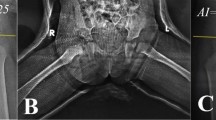Abstract
Ninety-nine hips treated by the Chiari pelvic osteotomy were included in this study designed as a retrospective review. The group consisted of 36 male and 50 female patients, with mean age of 15.6 years. Each was diagnosed with developmental dysplasia of the hip (DDH) or avascular necrosis of the femoral head—Legg-Calve-Perthes disease (LCP)—and postreduction avascular necrosis (PAN). Five hip parameters (the acetabular angle of Sharp, the center-edge (CE) angle of Wiberg, the percentage of femoral head uncoverage, the acetabular depth ratio, and the Shenton-Menard arch continuity) were evaluated. Functional outcome was assessed according to Harris hip score (HHS) and McKay criteria for clinical evaluation. The postoperative results showed improvement in all the radiographic parameters. The angle of Sharp showed a decrease of 8.62º (p < 0.01). The CE angle of Wiberg showed an increase of 28.76º (p < 0.01), and the uncoverage of the femoral head showed a decrease of 51.51% (p < 0.01). The improvement of HHS was 11.93 (p < 0.05). The patients’ satisfaction was indicated by grade 4.1 ± 0.94 and the doctor’s satisfaction by grade 3.7 ± 1.16. The Chiari pelvic osteotomy, in spite of the development of biologically better procedures, has retained its position in the treatment of adolescent hip disorders.



Similar content being viewed by others
References
Macnicol MF, Lo HK, Yong KF (2004) Pelvic remodelling after the Chiari osteotomy. J Bone Joint Surg Br 86:648–654
Karami M, Franck F, Ilharreborde B, Pennecot GF, Mazda K, Bensahel H (2008) The results of Chiari pelvic osteotomy in adolescents with a brief literature review. J Child Orthop 2:63–68
Vukasinovic Z, Pellillo F, Spasovski D, Seslija I, Zivkovic Z, Matanovic D (2009) Triple pelvic osteotomy for treatment of residual hip dysplasia. Analysis of complications. Hip International 19:315–322
Vukasinovic Z, Vucetic C, Cobeljic G, Bascarevic Z, Slavkovic N (2006) Developmental dislocation of the hip is still important problem—therapeutic guidelines. Acta Chir Iugosl 53:17–19
Chiari K (1974) Medial displacement osteotomy of the pelvis. Clin Orthop 98:55–71
Vukasinovic Z, Ljubodrag Z, Vukadin O (1997) Radiographic assessment of the hip by measurement of different angles and indices. Acta Orthop Iugosl 28:27–31
Sharp IK (1961) Acetabular dysplasia. J Bone Joint Surg 43:268–772
Nelitz M, Guenthner KP, Gunkel S, Puhl W (1999) Reliability of radiological measurements in the assessment of hip dysplasia in adults. Br J Radiol 72:331–334
Tezeren G, Tukenmez M, Bulut O, Percin S, Cekin T (2005) The surgical treatment of developmental dislocation of the hip in older children: A comparative study. Acta Orthop Belg 71:678–685
Harris WH (1969) Traumatic arthritis of the hip after dislocation and acetabular fractures: treatment by mold arthroplasty. J Bone Joint Surg Am 51:737–755
McKay DW (1974) A comparison of the innominate and pericapsular osteotomy in the treatment of congenital dislocation of the hip. Clin Orthop 98:124–132
Jandric S, Manojlovic S (2009) Quality of life of men and women with osteoarthritis of the hip and arthroplasty: Assessment by WOMAC questionnaire. Am J Phys Med Rehabil 88:328–335
Ohashi H, Hirohashi K, Yamano Y (2000) Factors influencing the outcome of Chiari pelvic osteotomy: a long-term follow-up. J Bone Joint Surg Br 82:517–525
Calvert PT, August AC, Albert JS, Kemp HB, Catterall A (1987) The Chiari pelvic osteotomy. A review of the long-term results. J Bone Joint Surg Br 69:551–555
Rejholec M, Stryhal F, Rybka V, Popelka S (1990) Chiari osteotomy of the pelvis: a long-term study. J Pediatr Orthop 10:21–27
Kotz R, Chiari C, Hofstaetter JG, Lunzer A, Peloschek P (2009) Long-term experience with Chiari’s osteotomy. Clin Orthop Relat Res 467:2215–2220
Yanagimoto S, Hotta H, Izumida R, Sakamaki T (2005) Long-term results of Chiari pelvic osteotomy in patients with developmental dysplasia of the hip: indications for Chiari pelvic osteotomy according to disease stage and femoral head shape. J Orthop Sci 10:557–563
Rozkydal Z, Kovanda M (2003) Chiari pelvic osteotomy in the management of developmental hip dysplasia: a long term follow-up. Bratisl Lek Listy 104:7–13
Betz RR, Kumar SJ, Palmer CT, MacEwen GD (1988) Chiari pelvic osteotomy in children and young adults. J Bone Joint Surg Am 70:182–191
Høgh J, Macnicol MF (1987) The Chiari pelvic osteotomy. A long-term review of clinical and radiographic results. J Bone Joint Surg Br 69:365–373
Vukasinovic Z, Spasovski D, Vucetic C, Cobeljic G, Zivkovic Z, Matanovic D (2009) Triple pelvic osteotomy in the treatment of Legg-Calve-Perthes disease. Int Orthop 33:1377–1383
Ko JY, Wang CJ, Jef Lin CF, Shih CH (2002) Periacetabular osteotomy through a modified ollier transtrochanteric approach for treatment of painful dysplastic hips. J Bone Joint Surg Am 84:1594–1604
Jan MH, Hung JY, Lin JC, Wang SF, Liu TK, Tang PF (2004) Effects of a home program on strength, walking speed, and function after total hip replacement. Arch Phys Med Rehabil 85:1943–1951
Winkelmann W (1984) The narrowing of the bone pelvic cavity (birth canal) by the different osteotomies of the pelvis. Arch Orthop Trauma Surg 102:159–162
Loder RT (2002) The long-term effect of pelvic osteotomy on birth canal size. Arch Orthop Trauma Surg 122:29–34
Hashemi-Nejad A, Haddad FS, Tong KM, Muirhead-Allwood SK, Catterall A (2002) Does Chiari osteotomy compromise subsequent total hip arthroplasty? J Arthroplasty 17:731–739
Minoda Y, Kadowaki T, Kim M (2006) Total hip arthroplasty of dysplastic hip after previous Chiari pelvic osteotomy. Arch Orthop Trauma Surg 126:394–400
Author information
Authors and Affiliations
Corresponding author
Rights and permissions
About this article
Cite this article
Vukasinovic, Z., Spasovski, D., Slavkovic, N. et al. Chiari pelvic osteotomy in the treatment of adolescent hip disorders: possibilities, limitations and complications. International Orthopaedics (SICOT) 35, 1203–1208 (2011). https://doi.org/10.1007/s00264-010-1126-1
Received:
Revised:
Accepted:
Published:
Issue Date:
DOI: https://doi.org/10.1007/s00264-010-1126-1




